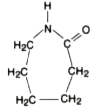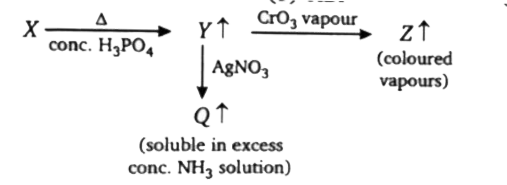Which of the following polymers can be made by anionic addition polymerisation mechanism?
The correct Answer is:A, B, C
To determine which polymers can be made by anionic addition polymerization mechanism, we will follow these steps:
Step 1: Understand Anionic Addition Polymerization
Anionic addition polymerization is a type of chain growth polymerization that involves the formation of a polymer from vinyl monomers. This process requires the presence of an electron-withdrawing group to stabilize the negative charge that forms during the reaction.
Hint: Remember that anionic polymerization involves the stabilization of carbanions through the delocalization of negative charge.
Step 2: Identify the Characteristics of Suitable Monomers
For anionic addition polymerization to occur, the monomers must typically contain vinyl groups (C=C) and should be capable of stabilizing the negative charge. Common electron-withdrawing groups that can stabilize the carbanion include cyano groups and halogens.
Hint: Look for monomers that have vinyl structures and electron-withdrawing groups.
Step 3: Analyze the Given Polymers
Now, we will analyze the provided options:
1. Polyvinyl Chloride (PVC) - This polymer is made from the monomer vinyl chloride (C2H3Cl), which contains a vinyl group and a chlorine atom (an electron-withdrawing group). Therefore, PVC can be made via anionic addition polymerization.
2. Teflon (Polytetrafluoroethylene) - Teflon is made from the monomer tetrafluoroethylene (C2F4), which also contains a vinyl group and multiple fluorine atoms (strong electron-withdrawing groups). Thus, Teflon can also be synthesized through anionic addition polymerization.
3. Polypropylene (PP) - Polypropylene is made from the monomer propylene (C3H6), which does not contain any significant electron-withdrawing groups to stabilize the carbanion. Therefore, polypropylene is typically produced through cationic polymerization, not anionic.
Hint: Check if the monomers have the necessary characteristics for anionic polymerization.
Step 4: Conclusion
Based on the analysis, the polymers that can be made by anionic addition polymerization are:
- Polyvinyl Chloride (PVC)
- Teflon (Polytetrafluoroethylene)
Thus, the answer is that the first and second options can be made by anionic addition polymerization.
Final Answer: Polyvinyl Chloride (PVC) and Teflon (Polytetrafluoroethylene) can be made by anionic addition polymerization.
Anionic addition polymerization is a type of chain growth polymerization that involves the formation of a polymer from vinyl monomers. This process requires the presence of an electron-withdrawing group to stabilize the negative charge that forms during the reaction.
For anionic addition polymerization to occur, the monomers must typically contain vinyl groups (C=C) and should be capable of stabilizing the negative charge. Common electron-withdrawing groups that can stabilize the carbanion include cyano groups and halogens.
Now, we will analyze the provided options:
1. Polyvinyl Chloride (PVC) - This polymer is made from the monomer vinyl chloride (C2H3Cl), which contains a vinyl group and a chlorine atom (an electron-withdrawing group). Therefore, PVC can be made via anionic addition polymerization.
2. Teflon (Polytetrafluoroethylene) - Teflon is made from the monomer tetrafluoroethylene (C2F4), which also contains a vinyl group and multiple fluorine atoms (strong electron-withdrawing groups). Thus, Teflon can also be synthesized through anionic addition polymerization.
Based on the analysis, the polymers that can be made by anionic addition polymerization are:
- Polyvinyl Chloride (PVC)
- Teflon (Polytetrafluoroethylene)
Topper's Solved these Questions
- BOOK - CENGAGE CHEMISTRY ENGLISHCHAPTER - SYNTHETIC AND NATURAL POLYMERSEXERCISE - Exercises Single Correct94videos
SYNTHETIC AND NATURAL POLYMERS
- BOOK - CENGAGE CHEMISTRY ENGLISHCHAPTER - SYNTHETIC AND NATURAL POLYMERSEXERCISE - Exercises Assertion Reasoning10videos
SYNTHETIC AND NATURAL POLYMERS
- BOOK - CENGAGE CHEMISTRY ENGLISHCHAPTER - SYNTHETIC AND NATURAL POLYMERSEXERCISE - Exercises Linked Comprehension30videos
SYNTHETIC AND NATURAL POLYMERS
- BOOK - CENGAGE CHEMISTRY ENGLISHCHAPTER - SURFACE CHEMISTRYEXERCISE - Archives Subjective2videos
SURFACE CHEMISTRY
Similar Questions
Knowledge Check
- Question 1 - Select One
Which of the following polymers is prepared by condensation polymerisation?
AStyreneBNylon-66CTeflonDRubber - Question 2 - Select One
Which of the following polymer can be formed by using the monomer unit?
 ANylon 6, 6BNylon-2-nylon-6CMelamine polymerDNylon-6
ANylon 6, 6BNylon-2-nylon-6CMelamine polymerDNylon-6
Which of the following polymers can be made by additional polymersation reaction?
View SolutionWhich of the following can be made into crystal?
View SolutionWhich one of the following polymers in not obtained by condensation polymerisation ?
View SolutionWhich of the following polymers are thermoplastic?
View Solution
Which of the following anion cannot be in X?View Solution
Which of the following anion cannot be in X?View Solution
